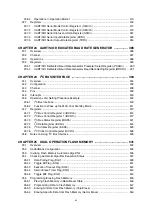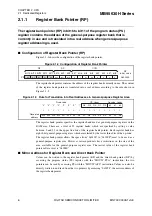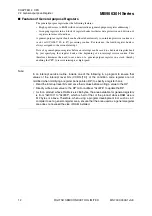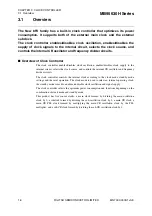
MB95630H Series
MN702-00009-1v0-E
FUJITSU SEMICONDUCTOR LIMITED
5
CHAPTER 2 CPU
2.1 Dedicated Registers
●
Temporary accumulator (T)
The temporary accumulator is an auxiliary 16-bit register for arithmetic operation. It is used to
perform arithmetic operations with the data in the accumulator (A). The data in the temporary
accumulator is handled as word data for word-length (16-bit) operations with the accumulator
(A) and as byte data for byte-length (8-bit) operations. For byte-length operations, only the
lower eight bits (TL) of the temporary accumulator are used and the upper eight bits (TH) are
not used.
When a MOV instruction is used to transfer data to the accumulator (A), the previous contents
of the accumulator are automatically transferred to the temporary accumulator. When
transferring byte-length data, the upper eight bits (TH) of the temporary accumulator remain
unchanged. The initial value after a reset is "0x0000".
●
Index register (IX)
The index register is a 16-bit register used to hold the index address. The index register is used
with a single-byte offset (-128 to +127). The offset value is added to the index address to
generate the memory address for data access. The initial value after a reset is "0x0000".
●
Extra pointer (EP)
The extra pointer is a 16-bit register which contains the value indicating the memory address
for data access. The initial value after a reset is "0x0000".
●
Stack pointer (SP)
The stack pointer is a 16-bit register which holds the address referenced when an interrupt or a
sub-routine call occurs and by the stack push and pop instructions. During program execution,
the value of the stack pointer indicates the address of the most recent data pushed onto the
stack. The initial value after a reset is "0x0000".
●
Program status (PS)
The program status is a 16-bit control register. The upper eight bits consists of the register bank
pointer (RP) and direct bank pointer (DP); the lower eight bits consists of the condition code
register (CCR).
In the upper eight bits, the upper five bits consists of the register bank pointer used to contain
the address of the general-purpose register bank. The lower three bits consists of the direct
bank pointer which locates the area to be accessed at high-speed by direct addressing.
The lower eight bits consists of the condition code register (CCR) which consists of flags that
represent the state of the CPU.
The instructions that can access the program status are "MOVW A,PS" and "MOVW PS,A".
The register bank pointer (RP) and direct bank pointer (DP) in the program status register can
also be read from and written to by accessing the mirror address (0x0078).
Note that the condition code register (CCR) is a part of the program status register and cannot
be accessed independently.
Refer to the "F
2
MC-8FX Programming Manual" for details on using the dedicated registers.
















































